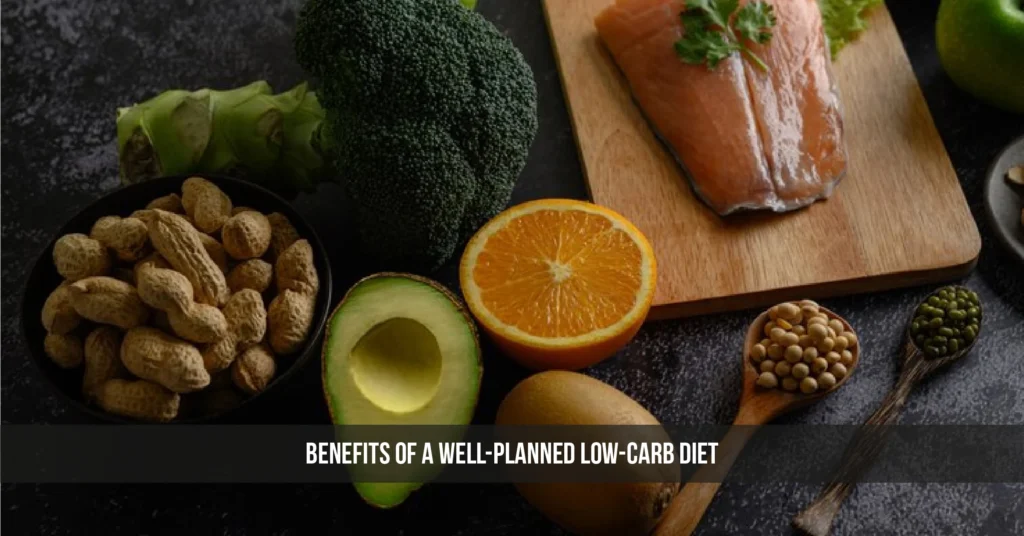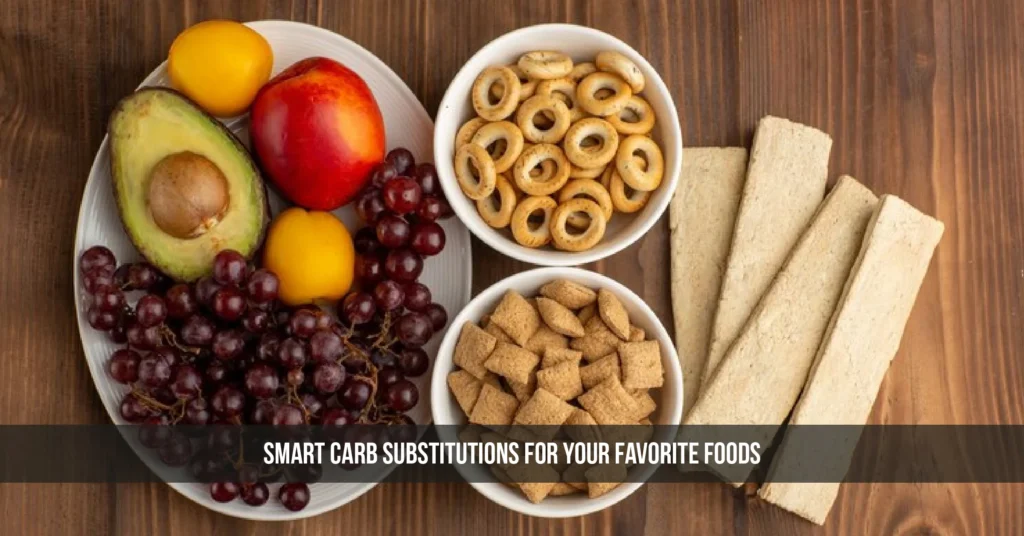How to Go Low-Carb Without Compromising Your Health
When you think about a low-carb diet, you want it to be good for your health. It’s important to learn how to cut carbs without losing health benefits. A well-thought-out low-carb diet can bring many benefits, but it needs to be balanced.
By understanding how to reduce carbs, you can make a diet that suits you. This way, you can reach your health goals and still enjoy your favorite foods.
Starting to cut down on carbs is a big step. It’s key to focus on keeping health benefits while doing it. A low-carb diet can really improve your health if done right.
By making smart choices and watching your carb intake, you can enjoy the good sides of a low-carb diet. With the right approach, it can become a lasting part of your life.
Understanding the Basics of Healthy Carb Reduction
Reducing carb intake starts with knowing how carbs work in our bodies. Carbs are the main energy source for our cells. They come in different types. To choose carbs wisely, it’s important to know the difference between simple, complex, and fiber-rich carbs.
Simple carbs, like sugars, are quickly digested. Complex carbs, such as whole grains, take longer to break down. Fiber-rich carbs, found in fruits and vegetables, are filling and provide essential nutrients.
Learning about carb metabolism helps you make better diet choices. Carb reduction tips often suggest eating fewer simple carbs and more complex and fiber-rich ones. This keeps your energy up and supports your health. Making smart carb choices is key to a balanced diet and better health.
What Are Carbohydrates and Their Role
Carbohydrates are one of the three main nutrients, along with proteins and fats. They are the body’s main energy source and are vital for many functions. From a diet standpoint, carbs are simple or complex. Simple carbs are in sweets and white bread, while complex carbs are in whole grains, fruits, and vegetables.
Different Types of Carbs Explained
The main carb types are:
- Simple carbs: sugars, honey, maple syrup
- Complex carbs: whole grains, legumes, starchy vegetables
- Fiber-rich carbs: fruits, vegetables, whole grains
Choosing complex and fiber-rich carbs supports your health and well-being.
The Science Behind Carb Metabolism
Carb metabolism breaks carbs into glucose for our cells’ energy. The science is complex, but knowing the basics helps in diet choices. By following carb reduction tips and choosing healthy carbs, you can keep your diet balanced and support your health.
Benefits of a Well-Planned Low-Carb Diet
Reducing carbs can lead to weight loss and better blood sugar control. Many studies show that a low-carb diet improves health. Knowing these benefits helps you make better diet choices.
Some key benefits of a low-carb diet include:
- Weight loss: Lower carb intake helps your body use fat for energy, leading to weight loss.
- Improved blood sugar control: It’s great for people with diabetes, helping to keep blood sugar levels stable.
- Improved cardiovascular health: It can also lower bad cholesterol and increase good cholesterol.
Remember, a well-planned low-carb diet is crucial for these benefits. Focus on whole, nutrient-rich foods and watch your carb intake. Remember, it’s all about balance and making informed choices. With the right approach, you can enjoy the benefits of reducing carbs and improving your health.

How to Minimize Carbs Without Losing Health Benefits
It’s key to find a balance when cutting down on carbs. You want to keep your diet full of nutrients. Focus on whole grains, fruits, and veggies for fiber, vitamins, and minerals.
Eating whole, unprocessed foods is a smart move. It ensures you get the nutrients you need while controlling carbs. A meal with lean protein, healthy fats, and complex carbs keeps you full and supports your health.
Identifying Essential Carb Sources
- Whole grains, such as brown rice, quinoa, and whole-wheat bread
- Fruits, such as berries, citrus fruits, and apples
- Vegetables, such as leafy greens, broccoli, and bell peppers
Maintaining Nutritional Balance
To keep your diet balanced, make sure you get enough protein, healthy fats, and fiber. Include a variety of whole foods in your meals and snacks. This way, you manage carbs and support your health and well-being.
| Food Group | Examples | Nutritional Benefits |
|---|---|---|
| Protein | Lean meats, fish, eggs, and legumes | Builds and repairs tissues, supports immune function |
| Healthy Fats | Nuts, seeds, avocados, and olive oil | Supports heart health, provides energy |
| Fiber | Whole grains, fruits, and vegetables | Supports digestive health, promotes satiety |
Smart Carb Substitutions for Your Favorite Foods
Carb-conscious eating is all about smart swaps for your favorite foods. By using carb-conscious recipes, you can enjoy your favorite tastes while watching your carb intake. Whether you’re craving a hearty breakfast, a fulfilling lunch, or a quick snack, there are many tasty, healthy options to try.
For breakfast, swap out pancakes and waffles for lower-carb alternatives like scrambled eggs with spinach and mushrooms, or Greek yogurt with berries and nuts. At lunch and dinner, replace high-carb sides like bread and pasta with roasted vegetables or a fresh green salad. For snacks, choose fresh fruit or raw almonds instead of chips or cookies.
Breakfast Alternatives
- Scrambled eggs with spinach and mushrooms
- Greek yogurt with berries and nuts
- Avocado toast on whole-grain bread
Lunch and Dinner Swaps
- Grilled chicken or fish with roasted vegetables
- Salads with lean protein and healthy fats
- Cauliflower rice or zucchini noodles instead of traditional pasta
Snack Options
- Fresh fruit or cut veggies with hummus
- Raw almonds or cashews
- Protein smoothies with Greek yogurt and berries
| Food | Carb-Conscious Alternative |
|---|---|
| Pancakes | Scrambled eggs with spinach and mushrooms |
| Pasta | Zucchini noodles or cauliflower rice |
| White bread | Whole-grain bread or a portobello mushroom cap |

Creating Your Low-Carb Meal Plan
To make a low-carb meal plan that fits you, think about what you need, like, and do every day. A good low-carb diet helps you reach your health goals and get all the nutrients you need. First, figure out how many carbs you should eat each day and what nutrients you need.
Focus on eating whole, unprocessed foods like veggies, lean proteins, and healthy fats. These foods have fewer carbs and more nutrients. You can also find low-carb versions of your favorite foods, like cauliflower rice or zucchini noodles.
A sample low-carb meal plan might include:
- Breakfast: scrambled eggs with spinach and avocado
- Lunch: grilled chicken breast with roasted vegetables
- Dinner: baked salmon with cauliflower rice and green beans
Drink lots of water all day to stay hydrated. You might also want to talk to a healthcare pro or a dietitian to make a meal plan that’s just right for you.
| Food | Carb Content | Portion Size |
|---|---|---|
| Chicken breast | 0g | 3-4 oz |
| Broccoli | 5g | 1 cup |
| Almonds | 6g | 1 oz |
By sticking to a well-planned low-carb diet and staying focused on your goals, you can live a healthier and more balanced life. Always choose whole, nutrient-rich foods. And don’t hesitate to ask a healthcare pro for advice if you have any questions.
Essential Nutrients to Focus On While Reducing Carbs
Starting a low-carb lifestyle means paying attention to important nutrients. Cutting down on carbs can lead to missing out on some nutrients if not done right. A good low-carb diet should have foods rich in vitamins, minerals, fiber, and protein.
When you’re on a low-carb diet, remember to watch your nutrient intake. Fiber is key for your digestive health and can be found in veggies, nuts, and seeds. Protein is also crucial for muscle health and can be found in lean meats, fish, and eggs.
Key Vitamins and Minerals
Some vitamins and minerals are especially important on a low-carb diet. These include vitamin D, calcium, and iron, which are good for bones and energy. You can get these from fatty fish, dairy, and leafy greens.
Fiber Sources on a Low-Carb Diet
Fiber is also very important. Eat foods like avocados, berries, and low-carb veggies to get enough fiber. High fiber helps you feel full and keeps blood sugar levels healthy.
Protein Requirements
Getting enough protein is key for muscle health and feeling full. Try to have a protein source at every meal, like lean meats, fish, eggs, tofu, or legumes. This supports your health on a low-carb diet.
Managing Exercise and Energy Levels
When managing carbs for health, balancing diet with exercise is key. Reducing carbs can lower energy, especially at first. To fight this, try moderate-intensity exercises like brisk walking, cycling, or swimming. These activities boost heart health without using too many carbs.
A good exercise plan can also help manage carbs for health. It improves how your body uses insulin and glucose. Here are some tips for a better workout:
- Begin with gentle exercises and slowly make them harder as you get used to the diet.
- Add strength training to build muscle, which helps control blood sugar.
- Rest when you need to, as too much exercise can cause energy drops and less motivation.
Also, watch your intake of protein and healthy fats to keep your energy up during workouts. Make sure your meals have a good mix of these nutrients. This balance between diet and exercise helps manage energy and promotes a healthier life.
| Exercise Type | Intensity Level | Benefits |
|---|---|---|
| Brisk Walking | Moderate | Improves cardiovascular health, increases energy levels |
| Cycling | Moderate to High | Enhances insulin sensitivity, boosts mood |
| Strength Training | High | Builds muscle mass, regulates blood sugar levels |
Common Mistakes to Avoid When Reducing Carbs
Learning to cut down on carbs without losing health benefits is key. It’s important to avoid common mistakes. Cutting carbs can help with weight loss and better blood sugar control. But, it must be done carefully to avoid nutrient deficiencies and low energy.
To avoid these errors, finding a balance is crucial. Pay attention to your carb intake and make sure you get enough nutrients from other foods. This way, you can cut carbs without losing health benefits and reach your diet goals.
Over-Restriction Pitfalls
- Nutrient deficiencies: Not enough carbs can cause fiber, vitamin, and mineral shortages.
- Decreased energy levels: Too few carbs can make you tired, weak, and less athletic.
- Negative impact on gut health: A low-carb diet can upset gut bacteria, causing digestive problems.
Balance and Moderation Tips
To keep a balanced carb reduction, eat whole, unprocessed foods. Choose vegetables, fruits, whole grains, lean proteins, and healthy fats. This way, you can cut carbs without losing health benefits and live a healthy, lasting lifestyle.
| Food Group | Recommended Daily Intake |
|---|---|
| Vegetables | 5-7 servings |
| Fruits | 2-3 servings |
| Whole Grains | 3-5 servings |
| Lean Proteins | 2-3 servings |
| Healthy Fats | 2-3 servings |

Monitoring Your Health During Carb Reduction
Starting a low-carb lifestyle means keeping a close eye on your health. Cutting down on carbs can greatly affect your body. It’s key to watch your health markers to ensure a safe and healthy change.
When you start a low-carb diet, watch your blood sugar, cholesterol, and kidney function. Regular check-ups with your doctor are crucial. They help you stay on track and make diet changes if needed. Paying attention to how your body reacts helps you make smart health choices.
Key Health Markers to Watch
- Blood sugar levels: Monitor your levels to ensure they are within a healthy range.
- Cholesterol: Keep an eye on your cholesterol levels to prevent any potential cardiovascular issues.
- Kidney function: Regularly check your kidney function to avoid any damage or complications.
When to Consult Healthcare Providers
If you notice any unusual symptoms or concerns, talk to your healthcare provider. They can give you personalized advice and support. Working together, you can make a healthy and successful switch to a low-carb lifestyle.
Sustainable Low-Carb Living Strategies
Starting a low-carb diet is more than just cutting carbs. It’s about living a healthy lifestyle. Set achievable goals and track your progress. Use a food diary or a mobile app to keep track of carbs and exercise.
Dealing with social pressures is key. Choose restaurants with low-carb options and ask for meal modifications. Prepare healthy meals in advance for work or events. Staying hydrated and getting enough sleep is also important for energy and health.
Here are some tips for a sustainable low-carb lifestyle:
- Plan meals ahead to avoid high-carb choices
- Buy low-carb ingredients and keep them at home
- Find low-carb alternatives to your favorite foods
- Stay connected with others who have similar health goals
By following these tips, your low-carb diet can be a lasting and enjoyable part of your life. Focus on gradual, long-term changes for better health and well-being.
Dealing with Social Situations and Dining Out
Following a low-carb diet can be tough in social situations and when dining out. But, with some planning, you can handle these challenges. It’s key to be careful about what you eat and to tell others about your diet.
Knowing the carbs in your food is crucial. When eating out, pick places with low-carb options. You can also ask your server for help finding something that fits your diet.
Restaurant Navigation Tips
- Research the restaurant’s menu beforehand to identify low-carb options
- Ask your server about the carbohydrate content of specific dishes
- Opt for grilled or baked foods instead of fried
- Choose vegetable-based sides instead of starchy ones
Social Event Strategies
At social events, being prepared is key. You might bring a low-carb dish to share or ask about the menu early. This way, you can enjoy the event while sticking to your diet.
Carb-conscious eating is about more than just cutting carbs. It’s about making smart food choices. By knowing the carbs in your food, you can eat healthier and keep your diet balanced.
Conclusion: Making Your Low-Carb Journey a Healthy Success
As you finish this guide, remember your low-carb journey is personal. You can minimize carbs without losing the health benefits you need. Find a balanced, sustainable way to low-carb living that fits you.
Choose nutrient-dense, low-carb foods and add carbs when needed. This keeps your energy up and your health good. With planning and tracking, you can enjoy a low-carb diet without harming your health.
Start this journey with an open mind and a willingness to try new things. Small, steady changes can greatly improve your health and life quality. Take charge of your carb intake and make your low-carb journey a success.
Also Read: How to Cook With Stainless Steel Cookware: Tips for Tasty Results
FAQs
What are the best low-carb foods to include in my diet?
Focus on whole, unprocessed foods like leafy greens, lean proteins, nuts, seeds, and healthy fats such as avocados and olive oil. These provide essential nutrients while keeping carb intake low.
How can I maintain energy levels on a low-carb diet?
Ensure you’re eating enough protein and healthy fats, stay hydrated, and incorporate moderate exercise. Gradually reducing carbs helps your body adjust without energy crashes.
Can I still enjoy my favorite foods on a low-carb diet?
Yes! Use smart substitutions like cauliflower rice, zucchini noodles, or almond flour for baking. Many recipes can be adapted to fit a low-carb lifestyle.
What are common mistakes to avoid when reducing carbs?
Avoid cutting carbs too drastically, neglecting fiber intake, or skipping nutrient-rich foods. Balance is key to maintaining health and energy while reducing carbs.
How do I handle social situations or dining out on a low-carb diet?
Plan ahead by checking menus, asking for modifications, or bringing a low-carb dish to share. Focus on protein and veggie-based options when dining out.














Post Comment